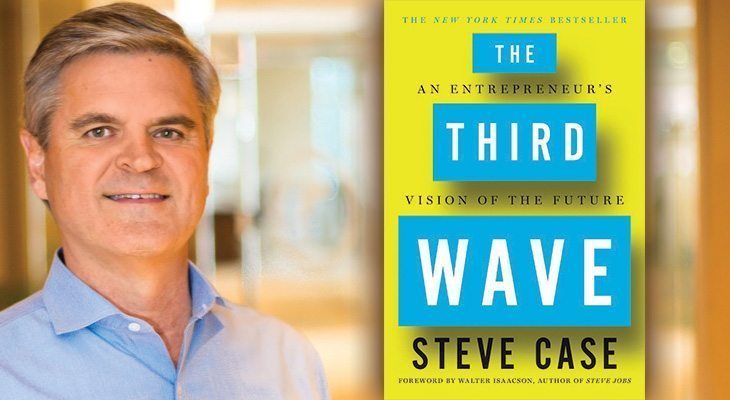The following excerpt was selected exclusively for StartupNation readers from “The Third Wave” by Steve Case. The excerpt shares Case’s process pitching his startup company, Quantum Computer Services, to Apple, and the journey that followed. Copyright © 2016 by Steve Case. Excerpted with permission by Simon & Schuster, a Division of Simon & Schuster, Inc.
The pitch resonated well with them. The people I was dealing with saw it as a way to be strategic, to strengthen their position within the company. On the one hand, they knew that their involvement was predicated on the partnership’s being about customer support. But they also saw that there was a broader opportunity—and that if online services took off, this was something that could transform their customer service department from being a drain to a profit center. A career-accelerating move, to be sure. So we seemed equally motivated to make the partnership work.
Had Steve Jobs been at Apple at the time, I suspect the deal would never have happened. Steve never would have licensed the Apple name or allowed such a critical decision to be made by lower-level executives. But Steve had been fired by Apple a couple of years earlier, so we had an opening. Six months after I’d moved to San Francisco, we finally inked a deal to build the service. It would be called AppleLink Personal Edition.
I moved back to DC, where the team greeted me like a conquering hero. Securing a partnership with Apple and convincing them to license their brand name to us was a coup. With Apple’s commitment and endorsement, we were able to bring in a $5 million round of funding—the most we had ever raised. We opened a Cupertino office not far from Apple’s headquarters so that our people could work in close collaboration with theirs. And we ramped up hiring to handle the Apple launch, which was going to be our biggest ever.
Once the early software prototype was ready, I had the chance to sit down with Alan Kay, one of the pioneers of the early computing era, to get his advice. In the 1970s, Kay was part of the team at Xerox PARC (Palo Alto Research Center) responsible for designing a programming language called Smalltalk, which could be used to network computers together and would later help inspire Apple’s early Macintosh computers. When I met with him, he was working as an Apple Fellow, living in Los Angeles. I flew down to get his take on our design and to ask for guidance in making the software more intuitive, something that was his—and Apple’s—specialty. It was an honor to sit with such a legend. But it would turn out to be one of the very few good days I had working with Apple. The honeymoon was short-lived.
We spent a year building the AppleLink service, and geared up for an ambitious (and expensive) launch. But from the beginning, our companies clashed. Apple wanted to sell the software and limit distribution to authorized Apple stores. We thought that approach was a terrible idea and ran counter to our whole strategy. We wanted to give the software away for free—in a wide range of retail stores, pre-installed on Apple computers, bundled with magazines and modems, and sent by mail. We wanted to make the initial trial free, too, so that it would be easier to convince people to try the service. We needed paying customers—but that meant making it as easy as possible for consumers to try us. (It’s ironic that two decades later, Apple’s success would be propelled by free software in their App Store). We argued bitterly for months, battling over various marketing approaches, without ever finding common ground. It bred frustration and distrust, and a growing skepticism inside Apple.
I was late to the office one morning; there’d been an accident near Dulles Airport, and traffic was backed up for miles. When I arrived, there was a note from my assistant on my desk marked “urgent.” A senior executive at Apple wanted to speak to me, she said, and he didn’t sound happy. On its face, there was nothing that unusual about the message. We’d been arguing with Apple for months, and I’d gotten an earful from plenty of their executives. I didn’t realize they’d be asking for a divorce.
“Listen, Case, bottom line is this,” the executive said sharply, when I finally called him back. “This was a mistake, and we need to cancel the deal. We’re out. It’s over.” I tried to change his mind, to see if there was any alternative, but even as the words came out, I knew it was futile. We were never going to
see eye to eye on strategy, and each was convinced the other was wrong.
It was over.






